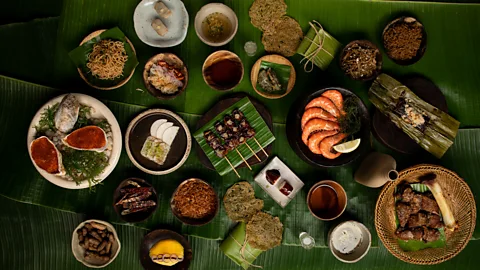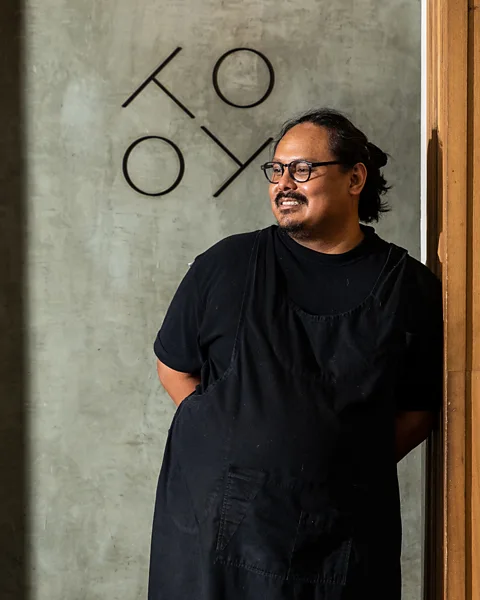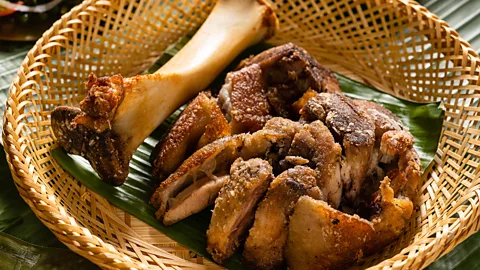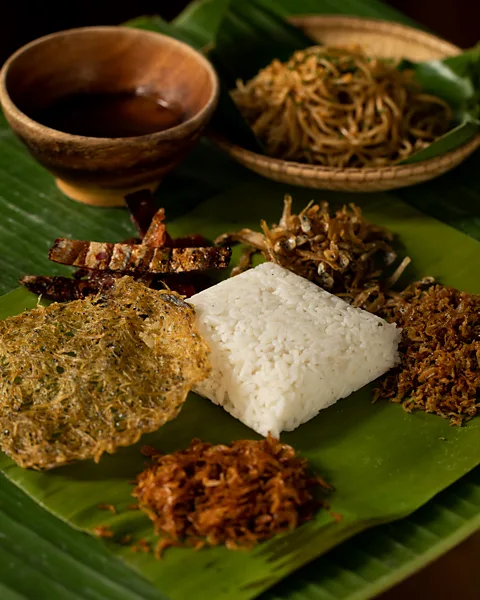Jordy Navarra's festive Filipino feast, served family-style
 Geric Cruz
Geric CruzOne of the Philippines' most acclaimed chefs shares his delicious take on Christmas dining – which is centred around sharing food and smoky flavours.
Softly spoken, gentle in nature and almost always smiling, Jordy Navarra is as far removed from the notion of a shouty, egotistical chef as you could imagine.
Having trained in famed restaurants including Heston Blumenthal's The Fat Duck near London, as well as Bo Innovation in Hong Kong, both of which attained the culinary holy grail of three Michelin stars, Navarra would be forgiven for having developed an oversized culinary ego.
Instead, he remains a modest but highly respected chef and restaurateur in his home country of the Philippines, someone who proudly flies the flag on the global stage for his nation's food and culture. Since opening in 2016, his Manila-based restaurant Toyo Eatery has won consistent critical and public acclaim, including being named the Best Restaurant in the Philippines by Asia's 50 Best Restaurants.
Just as significantly, the 39-year-old from Parañaque in Metro Manila has also ensured that Toyo (as it's commonly known) is one of Southeast Asia's most sustainable places to eat, working with a network of small farmers and producers to champion biodiversity and ingredients from across the Philippines' more than 7,000 islands.
The world's longest festive season?
Christmas is a big deal for Navarra, as it is for almost every Filipino. Shopping malls around the country famously have Christmas decorations up more than six weeks before Halloween, thanks to a 100-day Christmas countdown that starts on 16 September.
 Geric Cruz
Geric CruzThe intensity, commercialisation and duration of the festive season – with carols playing for more than a quarter of the year – can mean that expectations to deliver the perfect Christmas are raised sky-high. But the chance for families to come together, especially when millions of Filipinos live and work overseas, is priceless.
"I have fond memories of Christmas as I grew up without my brother and sister around as they were living in the US," Navarra explains, "so the holiday season was when they'd get to come home and visit. It was all about gathering, sharing food and catching up."
Noche Buena
As in Spain and much of Latin America, Filipinos primarily celebrate Christmas on Christmas Eve. With 85% of the population being Roman Catholic, attending mass is a crucial part of the celebrations, either in the evening or at midnight.
World's Table
BBC.com's World's Table "smashes the kitchen ceiling" by changing the way the world thinks about food, through the past, present and future.
Thereafter, the traditional Noche Buena (Good Night) feast takes centre stage. It’s a meal indelibly associated with Christmas, the treasured cultural equivalent of a roast turkey lunch or dinner which is served in many countries on 25 December.
A help-yourself table is generously decked out with plates including honey-cured ham, Edam cheese known locally as queso de bola, pan de sal (sweet soft bread rolls) and fluffy, sugar-topped ensaymada buns. To follow, there's tropical fruit salad that is often sweetened with condensed milk, fruit cake and tsokolate hot chocolate to drink, made from round tablets of roasted cocoa beans called tablea.
Families love to add other dishes to their festive Noche Buena table, and for Navarra this includes grilled seafood such as shrimp, grilled cuts of pork, or, if a lot of people are coming, lechon (a whole roast pig) that is a common showstopper at Christmas around the Philippines.
 Dre Ferrer
Dre FerrerA Christmas kamayan feast
However, as a chef who has championed his country’s rich indigenous food culture like few others, after Christmas Eve’s Noche Buena feast has been cleared away, Navarra chooses to serve a special meal on Christmas Day that celebrates ingredients and cooking techniques from across the country.
At home with family and friends, Navarra, enjoys the proudly Filipino tradition of communal eating, kamayan. Meaning "with hands" in Tagalog, the Philippines' most widely spoken language, kamayan denotes food that is served family-style atop banana leaves that are spread across tables.
It’s a form of dining that is often seen at communal celebrations throughout the year, from birthdays to family reunions – but rarely at Christmas. Navarra wanted to change that, not only at home but also at his restaurant Toyo, as he feels that the kamayan experience is defined by togetherness and sharing.
"We wanted to celebrate the way of eating and feeling you get with a Filipino vibe, a happy Christmas feeling with food that is all about sharing," he explains. "Using your hands to eat is a very Filipino, very intimate way to eat."
Rice and dried fish
Amongst all the dishes in his kamayan dinner at home, Navarra is adamant that the most important – as in any Filipino meal – is rice.
 Geric Cruz
Geric Cruz"Filipino food always revolves around rice, the ultimate comfort. We use a rice from Banaue then cook it and steam it in banana leaves – it's like sticky rice, but you still feel the individual grains. Cooking rice over a wood fire means you get those toasty notes. Then we want a contrast of temperatures, textures and taste profiles to go with it."
Those textures and taste profiles include different versions of tuyo, salted and dried fish.
"Pinindang is one type of dried fishmade with humoy-humoy, a sort of anchovy, which is shaped in a circle then sun-dried on leaves," he says. "It's obviously naturally salty and has pungent aromas of the sea. We discovered it in Antique Province where it's only produced in small quantities by local families, meaning the supply is very limited."
Kinilaw
He also serves a seafood dish called kinilaw, another native dish that proudly represents Filipino culinary heritage, as Navarra explains:
"Kinilaw is one of the simplest approaches to cooking in the Philippines but it's also profound as you try to highlight the taste of raw seafood using sourness and acid, whether fresh sourness from calamansi, a small, dark green citrus, or fermented from vinegar or bagoong. It's so good as the natural umami cuts through the richness of fish like mackerel or tuna."
 Dre Ferrer
Dre FerrerCrispy pata (Crispy pork hock)
No festive feast in the Philippines could ever be complete without some form of pork. At home on Christmas Day, Navarra serves the same cut and breed of pig as at his restaurant Toyo:
"Instead of a whole pig, we focus on the hock known as pata, using black pig from Batangas, which is a local crossbreed with Japanese Kurobuta pork. We cook it three times, first stewing it with typical Filipino aromatics including bay leaf, garlic and black pepper. Then we fry it cold, break it down and sear it in a cast iron pan for an extra laying of browning.”
More like this:
• How to prepare an Indigenous holiday meal
• Why no one does Christmas better than the Finns
• Kamayan feasts: The 'hands-only' meals that bring Filipinos together
In the Philippines, the must-haves with crispy pata are dipping sauces called sawsawan:
“We have two, one is a reduction of the broth, but there’s also homemade vinegar.So, you have a choice of dipping between a savoury and also a sour dip. You get fatty, crunchy bits of pork, which we all love and associate as very festive food, then also the nice crispy skin for contrast."
Grilled pork, dips and salad
A second iteration served on banana leaves for the festive kamayan menu is grilled pork. The love of all things smoky, charred and cooked on the grill runs deep in Navarra, as it does with millions of Filipinos: "Celebratory cooking in my family's household always included some form of grilled food," he explains. "My lola (grandmother) used to run a palengke (wet market), and outside it were barbecue joints that we would always buy from. To this day, it's still one of our go-to foods, whatever the occasion may be."
He pairs the pork with the sour, clean and salty notes of mangga at bagoong, a mango salad. The salad’s typically Filipino combination of flavours comes from slices of fermented green mangoes with ripe mangoes, which are mixed with bagoong, shrimp paste. Navarra makes the shrimp paste at home and also at his restaurant Toyo, one of many fermentations he crafts including vinegars and fish sauce called patis, made from any leftover fish.
Tupig and bibingka
For dessert, Navarra is a big fan of tupig, a rice cake cooked in banana leaf, made using sticky rice. Another sweet treat is a type of cassava cake that riffs on the Filipino Christmas classic, bibingka. Traditionally, these moreish, fluffy rice cakes, topped with coconut, brown sugar and melted butter, are cooked in banana leaves on charcoal braziers and sold outside church to be eaten after Christmas mass has ended.
 Geric Cruz
Geric CruzNavarra reflects on what makes his Christmas kamayan meal special: "Food just tastes better when you eat with your hands," he says. "It's also a nice change of pace from normal eating. A guest at the restaurant told me recently that as you use your hands to eat, you can't really touch your phone, meaning that you're more present – and in the moment."
That sounds like the perfect Christmas recipe.
--
If you liked this story, sign up for The Essential List newsletter – a handpicked selection of features, videos and can't-miss news, delivered to your inbox twice a week.
